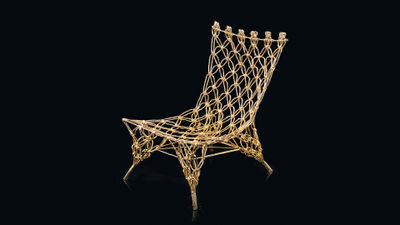User:JulietUlehake
Contents
Fantastic Forgeries, P2
Juliet Ulehake, 0914931
Chosen Artefact
Knotted Chair, Marcel Wanders
- Year: 1996
- Brand: Droog
- Material: carbon and aramid fibres , epoxy resin
- Product Size: 50 x 64 x 74 cm
Macramé was a popular handicraft pastime in the 1970s, but has since acquired a somewhat fusty image. In 1996, Marcel Wanders surprised the design world by developing a chair that was completely knotted in this way. Instead of the traditional rough sisal rope, he used ultramodern reinforced aramide. This lightweight chair combines industrial techniques and handcrafting. The thread constructed of aramid and carbon fibres, is knotted into the shape of a chair and then impregnated with epoxy resin and hung in a frame to dry, leaving the final form in the hands of gravity.
Droog Design started out in 1993 as a collective presentation by young Dutch designers at the annual furniture fair in Milan. The overwhelming success led Gijs Bakker and Renny Ramakers to develop the collection further and set up the Droog Design Foundation. Since then Droog Design has become known for its lucid and original design approach. Droog Design develops experimental products with clients, manufacturers and designers. One example of this is Dry Tech, a collaborative project between designers and researchers in the aerospace department at Delft University of Technology. One of the things created there was this Knotted Chair by Marcel Wanders.
At first, I wasn't that impressed by this chair. I though, oh okay, nice. I was about to move on when I saw that the chair was only made of two materials: fibres and resin. That sparked my interest. How could something that is known to me as fragile create such a solid object? A bit more research and I found out this chair can hold a grown man. My mind was blown and made up, this was the artefact I would be working with over the next few weeks.
“We had to make this chair in mid air, so we had to work with gravity, that it worked was a little miracle.” - Marcel Wanders
Copy
At first, I thought I was intrigued by the art of the macramé knotting. For my first version of my copy I therefore made my own macramé.
After talking with my teachers I realised it was not so much the look of the macramé, but my fascination about the added process creating new value of this technique. That's why I made another copy. Starting, again, by creating a macramé piece. The next step was impregnating it with epoxy resin to try and recreate a solid object out of such a fragile thing as knotted thread.
Transformation
Starting on my transformation, I first contemplated exploring materiality of fragile solidity. As sad before, I was intrigued by Wander's chair because the object itself looked fragile due to its use of material (rope) and its open structure. It seemed almost impossible to me that this object could be so sturdy. After thinking about it some more I came to the conclusion that I wasn't very excited about this idea. Instead of appropriating Wander's idea and find new ways of making the fragile solid, I wanted to appropriate his process of adding epoxy resin to rope but adding it into a different context to create new meaning.
At some point while I was scrolling through my facebook feed, I came across |this article, Toe naar minder plastic on National Geographic. It's #stopmetplastic month and after reading some more articles and getting a wake up call, I came to my new concept: rather than buying rope for this project, I'll make my own using plastic bags I had lying around my house. So why use plastic? If you have the time, definitely read some more articles on the subject, but here are some stats to summarise it.
World plastic production has increased exponentially from 2.3 million tons in 1950 to 162 million in 1993 to 448 million by 2015..
More than 40 percent of plastic is used just once, then tossed.





